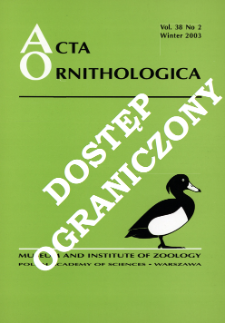
Object
Title: Differences between the spring and autumn migration of the red-backed shrike Lanius collurio: record from the Eilat stopover (Israel)
Subtitle:
Acta Ornithologica, vol. 37, no. 2 ; Migracje gąsiorka na obrzeżach pustyń: badania w Eilat, Izrael ; Red-backed shrike migration
Contributor:
Polska Akademia Nauk. Muzeum i Instytut Zoologii
Publisher:
Muzeum i Instytut Zoologii PAN
Place of publishing:
Description:
Bibliogr. p. 89-90 ; P. [85]-90 : ill. ; 27 cm ; Abstract in Polish. Taxa in Latin
Type of object:
Abstract:
Migratory Red-backed Shrikes were mist-netted during the spring and autumn migrations (n = 1031 individuals) from 1984 to 2001 in Eilat (Israel). In a similar pattern of trapping, more than four times as many shrikes were caught during autumn than in spring. Males migrated significantly earlier than females in spring but not during the autumn migration, which suggests that in males there is a stronger drive to reach their breeding territories early. In both seasons and between both sexes we did not find any significant relations between the body measurements of individuals and the time of passage. The spring migration lasted a much shorter time than the autumn one. This was expressed by the minimum stopover duration, as well as by the time when Red-backed Shrikes occurred in Eilat. There are significant differences between wing chord length, body mass and fat scores between seasons. In autumn, males had longer wings, and both sexes were heavier and in better condition than in spring. The data suggest that the differences are an adaptation to their having to cross the Sahara Desert. The birds spend a statistically significantly shorter period of time at the Eilat stopover site in spring than in autumn (median 1 ą 1.5 days vs 5 ą 6.5 days). In autumn, recaptured birds were 6.3% heavier than during the first capture. The change in body mass was significantly correlated to the duration of the stopover. The results suggest that migration over desert is energetically costly and that Eilat is a very important stopover site for migrating Red-backed Shrikes.
Relation:
Volume:
Issue:
Start page:
End page:
Detailed Resource Type:
Format:
Resource Identifier:
Source:
MiIZ PAN, call no. P.257-37-2 ; MiIZ PAN, call no. P.4568-37-2 ; click here to follow the link
Language:
Rights:
Rights Reserved - Restricted Access
Terms of use:
Digitizing institution:
Museum and Institute of Zoology of the Polish Academy of Sciences
Original in:
Library of the Museum and Institute of Zoology of the Polish Academy of Sciences
Projects co-financed by:
Programme Innovative Economy, 2010-2014, Priority Axis 2. R&D infrastructure ; European Union. European Regional Development Fund
Access:
Object collections:
- Digital Repository of Scientific Institutes > Partners' collections > Museum and Institute of Zoology PAS > Scientific Journals
- Digital Repository of Scientific Institutes > Partners' collections > Museum and Institute of Zoology PAS > MIZ PAN Publications > Acta Ornithologica
- Digital Repository of Scientific Institutes > Literature > Journals/Articles
Last modified:
Oct 2, 2020
In our library since:
Jun 10, 2014
Number of object content downloads / hits:
124
All available object's versions:
https://rcin.org.pl./publication/55576
Show description in RDF format:
Show description in RDFa format:
Show description in OAI-PMH format:
Objects Similar
Kuźniak, Stanisław (1933– ) Bednorz, Jan ( –2013) Tryjanowski, Piotr
Kuźniak, Stanisław (1933– )
Gotzman, Jerzy ( –2004)
Mielewczyk, Stefan (1933–2005)
Tryjanowski, Piotr Karg, Małgorzata K. Karg, Jerzy
Feliksiak, Stanisław (1906–1992)
Tryjanowski, Piotr Hromada, Martin (1969– ) Antczak, Marcin
Diehl, Barbara

 INSTYTUT ARCHEOLOGII I ETNOLOGII POLSKIEJ AKADEMII NAUK
INSTYTUT ARCHEOLOGII I ETNOLOGII POLSKIEJ AKADEMII NAUK
 INSTYTUT BADAŃ LITERACKICH POLSKIEJ AKADEMII NAUK
INSTYTUT BADAŃ LITERACKICH POLSKIEJ AKADEMII NAUK
 INSTYTUT BADAWCZY LEŚNICTWA
INSTYTUT BADAWCZY LEŚNICTWA
 INSTYTUT BIOLOGII DOŚWIADCZALNEJ IM. MARCELEGO NENCKIEGO POLSKIEJ AKADEMII NAUK
INSTYTUT BIOLOGII DOŚWIADCZALNEJ IM. MARCELEGO NENCKIEGO POLSKIEJ AKADEMII NAUK
 INSTYTUT BIOLOGII SSAKÓW POLSKIEJ AKADEMII NAUK
INSTYTUT BIOLOGII SSAKÓW POLSKIEJ AKADEMII NAUK
 INSTYTUT CHEMII FIZYCZNEJ PAN
INSTYTUT CHEMII FIZYCZNEJ PAN
 INSTYTUT CHEMII ORGANICZNEJ PAN
INSTYTUT CHEMII ORGANICZNEJ PAN
 INSTYTUT FILOZOFII I SOCJOLOGII PAN
INSTYTUT FILOZOFII I SOCJOLOGII PAN
 INSTYTUT GEOGRAFII I PRZESTRZENNEGO ZAGOSPODAROWANIA PAN
INSTYTUT GEOGRAFII I PRZESTRZENNEGO ZAGOSPODAROWANIA PAN
 INSTYTUT HISTORII im. TADEUSZA MANTEUFFLA POLSKIEJ AKADEMII NAUK
INSTYTUT HISTORII im. TADEUSZA MANTEUFFLA POLSKIEJ AKADEMII NAUK
 INSTYTUT JĘZYKA POLSKIEGO POLSKIEJ AKADEMII NAUK
INSTYTUT JĘZYKA POLSKIEGO POLSKIEJ AKADEMII NAUK
 INSTYTUT MATEMATYCZNY PAN
INSTYTUT MATEMATYCZNY PAN
 INSTYTUT MEDYCYNY DOŚWIADCZALNEJ I KLINICZNEJ IM.MIROSŁAWA MOSSAKOWSKIEGO POLSKIEJ AKADEMII NAUK
INSTYTUT MEDYCYNY DOŚWIADCZALNEJ I KLINICZNEJ IM.MIROSŁAWA MOSSAKOWSKIEGO POLSKIEJ AKADEMII NAUK
 INSTYTUT PODSTAWOWYCH PROBLEMÓW TECHNIKI PAN
INSTYTUT PODSTAWOWYCH PROBLEMÓW TECHNIKI PAN
 INSTYTUT SLAWISTYKI PAN
INSTYTUT SLAWISTYKI PAN
 SIEĆ BADAWCZA ŁUKASIEWICZ - INSTYTUT TECHNOLOGII MATERIAŁÓW ELEKTRONICZNYCH
SIEĆ BADAWCZA ŁUKASIEWICZ - INSTYTUT TECHNOLOGII MATERIAŁÓW ELEKTRONICZNYCH
 MUZEUM I INSTYTUT ZOOLOGII POLSKIEJ AKADEMII NAUK
MUZEUM I INSTYTUT ZOOLOGII POLSKIEJ AKADEMII NAUK
 INSTYTUT BADAŃ SYSTEMOWYCH PAN
INSTYTUT BADAŃ SYSTEMOWYCH PAN
 INSTYTUT BOTANIKI IM. WŁADYSŁAWA SZAFERA POLSKIEJ AKADEMII NAUK
INSTYTUT BOTANIKI IM. WŁADYSŁAWA SZAFERA POLSKIEJ AKADEMII NAUK


































